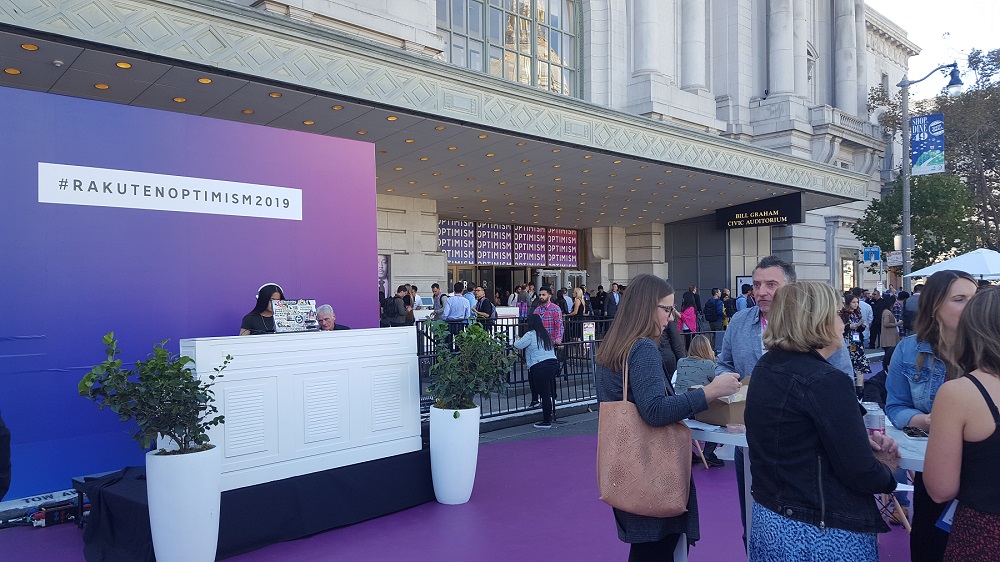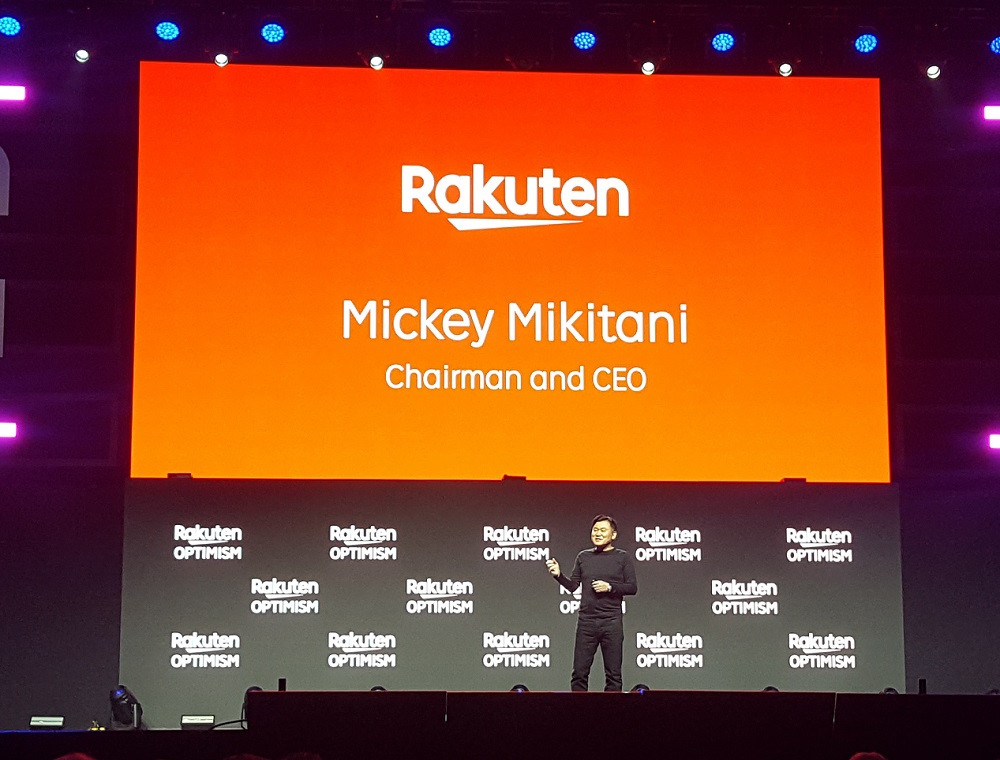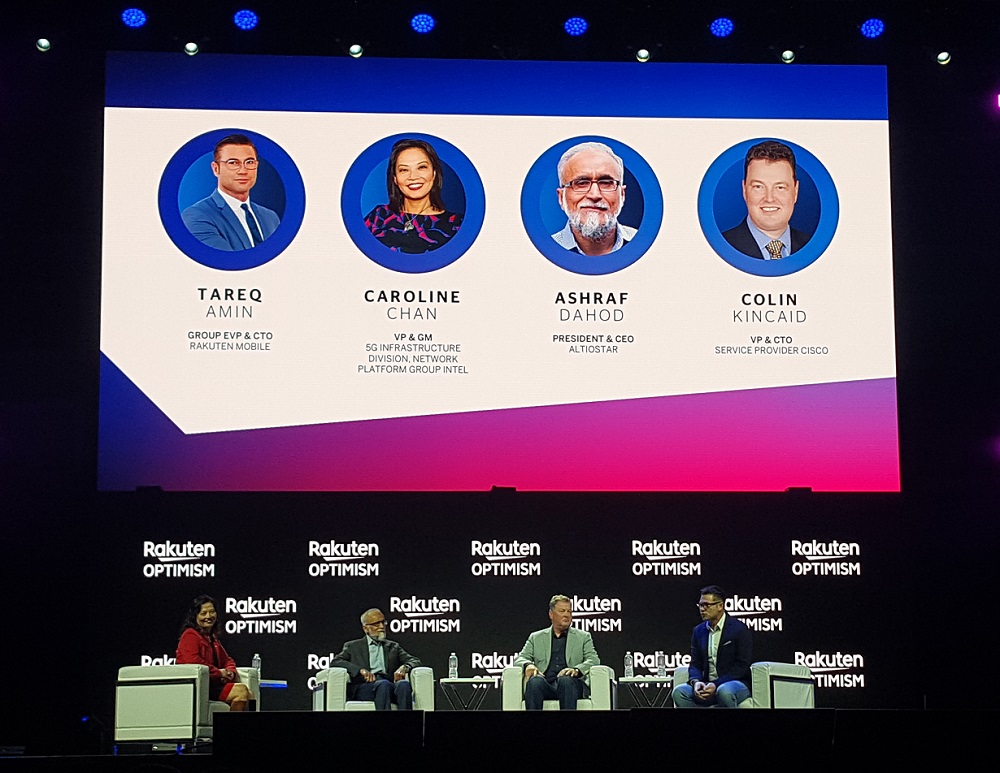
Optimism is Rakuten’s largest annual event drawing a crowd of 2,500 marketers in San Francisco to discuss digital technology trends, brand building ambitions and customer experience. This one day event took place in the Bill Graham Civic Auditorium and featured a crowd-pleasing lineup of world-class speakers including Marie Kondo, Daymond John, Gopi Kallayil, Jennifer Fleiss and more. Rakuten Optimism inspired thoughtful ideas and sparked interesting conversation through a host of activities: experience centers, pop-up shops, networking opportunities and live entertainment.
The fun and excitement kicked off with a welcome from Rakuten COO, Adrienne Down Coulson and a deeper look of what Optimism means to Rakuten.
Optimism can be explained through the Japanese term, Omotenashi, which means “hospitality,” the idea of putting people first. It implies a sense of selflessness and a commitment to providing everything necessary to ensure the customer’s utmost comfort. It’s understanding and knowing that everything has a place and a purpose in life, and if we place this idea of Omotenashi at the center of what we do, we can create better experiences for ourselves and others.
The day unfolded with Rakuten Americas CEO Amit Patel covering Rakuten’s entry into the Americas and warming up the stage for talks around how to inject human touch into a world of technology, the mobile network revolution and the era of 5G, branding building in the digital age, the power of storytelling and more. Below is a recap of some of the key takeaways from the event and digital marketing trends that should be top of mind as you plan your next move.

Human and Consumer Behavior Mandate Greater Tools to Service Them
Jennifer Fleiss, Co-Founder of Rent the Runway and head of Jetblack hit on a number of macro-trends within the e-commerce industry. One of which is time being the new luxury and the greatest commodity, leading to increased pressure for women to shop and influence household decisions. What was once a three to five day shipping window has turned into a two day shipping window for companies such as Amazon and other retail and fresh food delivery services. But catering to the busy mom, two days can be two days too long. With increased customer demand for speed and service, personalization, and options at their fingertips, companies face tremendous pressure to keep up. Amazon along with many others such as Instacart, Target, and Best Buy have now whittled their delivery window to same day delivery and even down to one hour according to RetailMeNot.
With consumers turning more to online shopping, they expect good service and dialogue with someone knowledgeable about the product -- not just a robot to take orders. Click To TweetWhile the race for speed and agility is one of the primary factors that set the standard, other customer pain points such as ease of shopping, modality of purchase and overall experience are driving steep changes in the retail market. For retail, companies need to keep in mind that shopping isn’t always transactional. With consumers turning more to online shopping, they expect good service and dialogue with someone knowledgeable about the product — not just a robot to take orders. With AI, machine learning and other smart technology, companies need to go beyond name recognition and really be able to invest in voice and conversational commerce as next generation technology to build trust, gather knowledge and insights about the customer, and create enjoyable shopping experiences as a competitive advantage to bring customers back for more.

The World of a Cashless Economy
Mickey Mikitani, Founder and CEO of Rakuten took the stage unveiling great excitement around Rakuten’s growth trajectory, strategic partnerships and lucrative investments to scale and build its brand presence in the US. Having made strategic partnerships with the Warriors, Spartans, Davis Cup and the Eagles, Rakuten demonstrates that the power of sports relationships is key in getting the brand to take flight. That along with its entry into the arena of “Smart Stadiums” will is one to keep a close eye on. There’s much criticism and controversy around building a cashless economy so using a sports stadium as a testing ground may be a great place to start. Countries such as Sweden, Denmark and Norway have already begun adopting the cashless economy in restaurants, coffee shops and local stores and I can attest that it’s fast, easy and convenient and a good way for the government and consumers to track cash flow. Will this the idea of a cashless economy take off in the US? Let’s first see how it does in the smart stadium.

The Gateway into the 5g Era
Rakuten’s next ambition is to bring to life its brand promise of building a cloud network that is fully virtualized, automated, software-centric — and where everything and everyone is connected through the 5G network. Tareq Amin, CTO of Rakuten Mobile moderated a panel around the 5G Era and Rakuten’s journey to this mobile revolution. He gave the audience a glimpse of how this technology breakthrough will revolutionize the Telco industry by enabling automation and service agility where software updates can take place daily rather than weekly or monthly. He discussed how it will revolutionize the Manufacturing industry by allowing for just-in-time manufacturing for brands such as Nike and German auto companies. He touched upon how 5G will impact the sporting industry by using sensors to monitor athlete’s performance and health. The journey to 5G will allow for faster connectivity, cost less, and enable continuous innovation, and Rakuten has become an emerging leader in the telecom space.
Brand Building in the Digital Age
The harsh reality of building a brand is that it’s not enough for you to slap on a fancy logo, orchestrate well-placed advertisements and hope that it will stand out and be recognizable. You really have to live and speak your brand promise, and show it through everything you do. Gopi Kallayil, Chief Evangelist of Brand at Google shared key insights about brands looking to build their identity and reposition themselves in the marketplace for their target audience. Gopi shared a few iconic examples of brands who were able to establish a strong emotional connection with their audience, create a brand experience that encouraged people to engage with them and build loyalty with their fan base.
Nike India: Make Every Yard Count
This Nike ad targeted the middle class in India and got them to embrace the brand by penetrating the Indian market through their all-time favorite sport, Cricket. Everyday athletes, 1440 of them to be precise, showed off their talent, athleticism and love for the sport by depicting scenes that made every yard count.
SONOS Speakers
SONOS looked to reposition themselves from an electronics brand to a lifestyle brand by marketing their smart speakers to music lovers and portraying the emotional experience you undergo through everyday life from newlyweds to marriage to having a baby to graduation to heartbreak and more. By airing these ads, Sonos saw a 37 percent lift in purchase intent for their smart speakers and home sound system products.
In the year ahead, rest assured that the era of 5G, the world of the cashless economy, and other digital technology trends will continue to take flight. Consumer demand will continue to drive increased speed, efficiency and personalization in the marketplace and change how we do business. The question is, will your brand keep up?
Consumer demand will continue to drive increased speed, efficiency and personalization in the marketplace and change how we do business. Click To Tweet

Follow Me